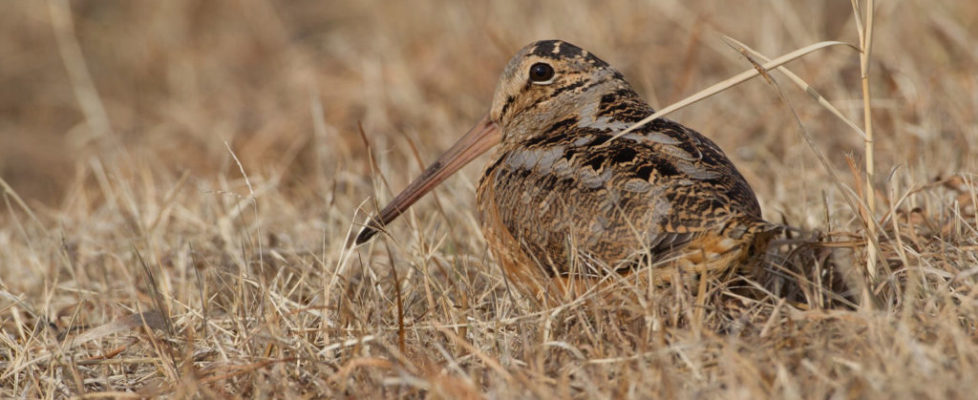Dance of the Timberdoodle
It’s the beginning of courtship season for the birds around here. The signs are everywhere: in the Mourning Dove’s puffed-up strut, the way Common Grackles and Red-winged Blackbirds seem to inflate themselves as they emit their raucous calls, the flood of birdsong we hear each dawn.
Among some exotic species—Birds of Paradise, Peacocks, cranes, and others—courtship rituals can be so dazzling that birders journey halfway around the world to see them. Most of our local birds’ displays, on the other hand, are comparatively subdued.
Most, that is, but not all. There is one memorable performance taking place right now nearly in our backyards: the sky dance of the male American Woodcock. Yet most people, including many who love birds, not only miss this show, but don’t even know it’s taking place. That’s because the birds dance only at and after dusk and for just a few brief weeks each spring.
Their courtship rituals aren’t the only memorable thing about Woodcocks. From their appearance to the way they move, everything about them is odd, ungainly, and appealing. This even includes the folk names they’ve acquired over the years: Timberdoodle, Bogsucker, Big-eye, Mudbat, and Night Partridge, among others.
Inhabiting the eastern half of the United States, Woodcocks are actually sandpipers, though you’ll almost never see one on a beach or mudflat. They have have vivid russet-and-brown plumage with crosswise black stripes across the top of the head like a balding man’s combover. They’re shaped roughly like a football…except a football doesn’t come equipped with a long, straight bill.
The bill’s resemblance to a straw most likely gave rise to the name “Bogsucker,” but the birds actually use it to probe the ground for earthworms (their favorite food) and other invertebrates. The end of the bill is flexible and comes equipped with sensitive nerve endings and rough edges, ideal adaptations for locating and snagging unseen prey.
Another part of the Woodcock’s hunting technique is especially odd and endearing. You may see one walking with an odd, stop-and-go stride, rocking back and forth and occasionally stomping a foot. What it’s doing is striking the ground and then listening for the sound of worms fleeing the vibrations. This form of sonar helps the bird strike accurately with its well-equipped bill. [View this Woodcock walk in the video below.]
Everything about the Woodcock is offbeat. But nothing can match the spectacle of the males’ courtship displays, the evening “sky dances” a lucky observer can listen to—and sometimes even watch—in this season.
Local parks and almost any area that features untended clearings—grassy roadsides, unmowed fields and pastures, openings within a forest—can make an acceptable staging ground for amorous Woodcocks. Here, as the light begins to fade, a male will begin his performance by making a far-carrying call, a loud, nasal “PEENT!” The best way to find a displaying male is to listen for and locate this call.
After several “PEENTS”, the bird will suddenly vault into the air and fly upwards at an astonishing speed. It’s breathtaking to watch one hurtle as much as 300 feet into the darkening sky, looking like an unlit firework or punted football. As the bird ascends, it makes wild twittering sound, which is not song but results from air rushing through specially adapted feathers on the bird’s wings.
At the crest of its ascent, a male Woodcock may hover or fly in a tight circle for several seconds. Then it will spiral or zigzag back to the ground, this time accompanying itself with musical chirps. The goal is to land beside an interested female, but regardless the Woodcock can continue its energetic ritual for an hour or more—or even, on moonlit nights, all night long.
Except in the dancing season, Woodcocks can be extremely difficult to find. They migrate at night, sleep during the day, and nest on the ground, usually in young forests where few humans or other large animals are likely to disturb them.
The best time of year to encounter one—or even a displaying ground full of them—is right now. To me, it’s always worth a special trip (and even a delayed dinner) for the opportunity to witness the magical nighttime dance of the Timberdoodle.
By Joseph Wallace
Copyright © 2022



